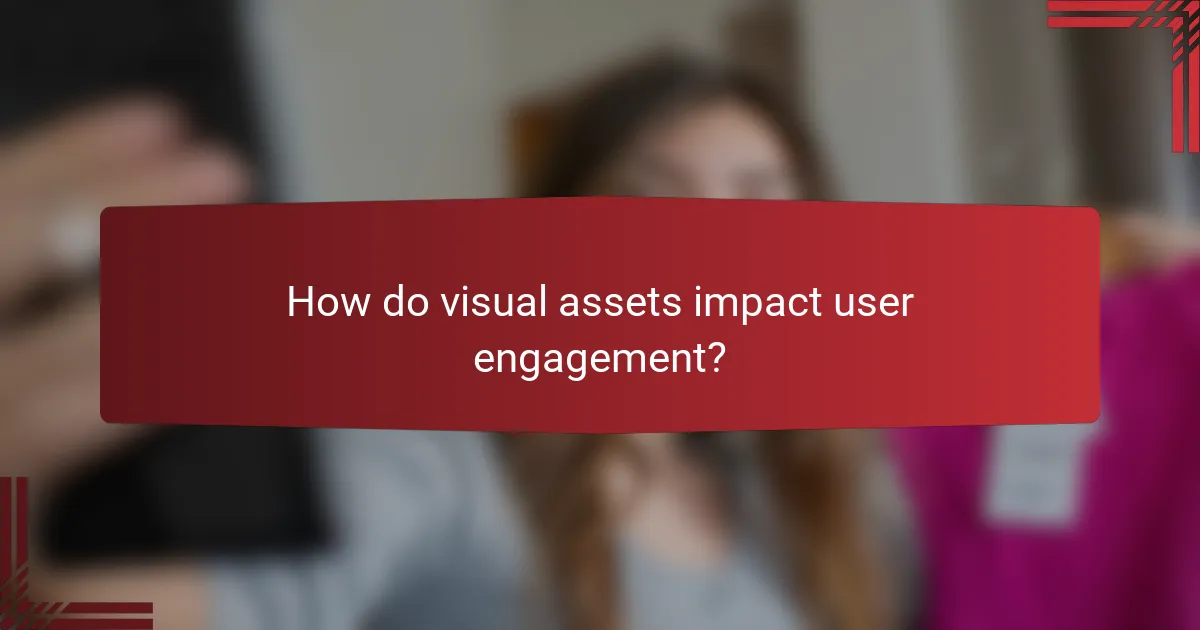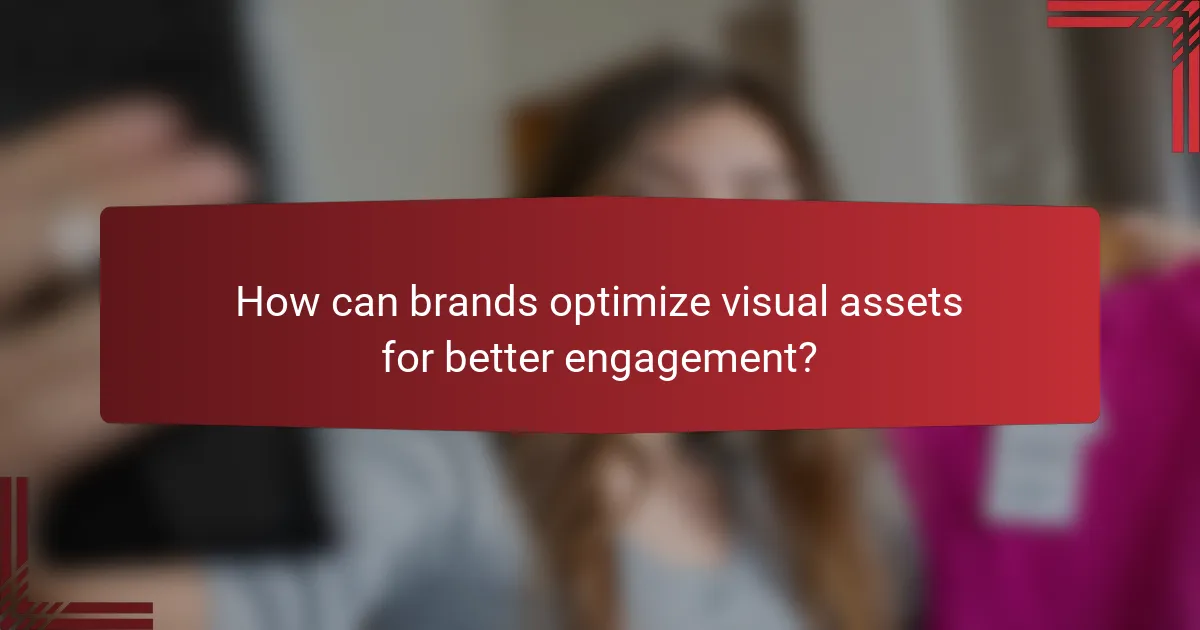Visual assets are essential for enhancing user engagement, as they capture attention and facilitate meaningful interactions with content. High-quality images, infographics, and videos not only improve perception but also cater to diverse audience preferences, making them vital for effective communication. By strategically optimizing these assets, brands can ensure they resonate with their target audience and adapt seamlessly across different platforms.

How do visual assets impact user engagement?
Visual assets significantly enhance user engagement by capturing attention and facilitating interaction. They play a crucial role in how users perceive and interact with content, leading to more meaningful experiences.
Increased retention rates
Visual assets can lead to higher retention rates by making content more memorable. Users are more likely to remember information presented with engaging images or videos compared to text-only formats. For example, incorporating infographics can boost retention by up to 80% compared to standard text.
To maximize retention, ensure that visuals are relevant and support the message. Avoid cluttered designs that can distract from the core content, as simplicity often aids memory retention.
Enhanced emotional connection
Visual assets foster an emotional connection with users, which can drive engagement. Images that evoke feelings or resonate with the audience’s experiences can create a stronger bond, making users more likely to interact with the content. For instance, using relatable imagery in marketing campaigns can increase conversion rates significantly.
When selecting visuals, consider the emotions you want to evoke. Authentic and relatable visuals often outperform generic stock images in creating connections with the audience.
Improved information retention
Visual assets improve information retention by presenting complex data in a digestible format. Charts, graphs, and videos can simplify intricate concepts, making them easier to understand and remember. Studies suggest that visuals can enhance comprehension by up to 60% when explaining complex topics.
To effectively use visuals for information retention, align them with the key points of your message. Use clear labels and concise explanations to ensure that users can easily grasp the information being presented.

What types of visual assets improve quality?
High-quality visual assets significantly enhance user engagement and overall content effectiveness. Key types include high-resolution images, infographics, and videos, each serving distinct purposes and appealing to different audience preferences.
High-resolution images
High-resolution images are essential for creating a professional and polished appearance. They capture details and colors more vividly, which can lead to increased user trust and interest. Aim for images with at least 300 DPI for print and 72 DPI for web use.
When selecting images, consider the context and relevance to your content. Use images that resonate with your target audience and avoid generic stock photos that may dilute your message. Tools like Adobe Stock or Shutterstock can provide quality options.
Infographics
Infographics combine visuals and data to convey complex information quickly and clearly. They are particularly effective for summarizing statistics or processes, making them easier to digest. Aim for a balance of text and visuals to maintain clarity.
When creating infographics, focus on a cohesive color scheme and clear typography. Use tools like Canva or Piktochart to design engaging infographics that can be easily shared across social media platforms, enhancing your reach.
Videos
Videos are powerful visual assets that can capture attention and convey messages more dynamically than static images. They can range from short clips to full-length tutorials, catering to various audience preferences. Keep videos concise, ideally under three minutes, to maintain viewer interest.
When producing videos, ensure high production quality by using good lighting and sound equipment. Platforms like YouTube or Vimeo can be utilized for hosting, while social media channels can help amplify your content’s visibility. Always include captions to improve accessibility and engagement.

How can brands optimize visual assets for better engagement?
Brands can enhance user engagement by strategically optimizing visual assets through methods like A/B testing, responsive design, and leveraging user-generated content. These approaches help ensure that visuals resonate with the target audience and adapt effectively across various platforms.
Using A/B testing
A/B testing allows brands to compare two or more versions of visual assets to determine which performs better in terms of user engagement. By analyzing metrics such as click-through rates or time spent on a page, brands can make informed decisions about which visuals to use.
When conducting A/B tests, it’s crucial to test one variable at a time, such as image size or color scheme. This focused approach helps isolate the impact of each change, leading to clearer insights. Aim for a sample size that reflects your audience, ideally in the low hundreds to thousands, depending on your traffic.
Implementing responsive design
Responsive design ensures that visual assets are optimized for various devices, from desktops to smartphones. This adaptability is essential as a significant portion of users access content on mobile devices, where screen sizes and resolutions vary widely.
To implement responsive design effectively, use flexible grid layouts and scalable images that adjust based on the user’s screen size. Tools like CSS media queries can help tailor visuals for different devices, enhancing user experience and engagement rates.
Leveraging user-generated content
User-generated content (UGC) can significantly boost engagement by providing authentic visuals that resonate with potential customers. Brands can encourage users to share their own images or videos featuring products, creating a sense of community and trust.
To effectively leverage UGC, brands should create campaigns that incentivize sharing, such as contests or hashtags. Displaying UGC prominently on websites or social media can enhance credibility and relatability, leading to increased interaction and conversion rates.

What are the best practices for visual asset creation?
Best practices for visual asset creation focus on ensuring quality, consistency, and engagement. By adhering to these principles, creators can enhance user experience and improve the effectiveness of their visual content.
Consistent branding
Consistent branding in visual assets helps establish a recognizable identity across all platforms. Use a uniform color palette, typography, and logo placement to create a cohesive look that resonates with your audience.
For example, if your brand uses a specific shade of blue, ensure that all visuals incorporate this color. This consistency reinforces brand recognition and builds trust with users.
Accessibility considerations
Accessibility in visual asset creation ensures that content is usable by people with disabilities. Use high-contrast colors, alt text for images, and clear fonts to make your visuals more inclusive.
Consider the Web Content Accessibility Guidelines (WCAG) when designing. For instance, ensure that text is readable for individuals with visual impairments by maintaining a minimum font size and using legible typefaces.
SEO optimization techniques
SEO optimization for visual assets involves using relevant keywords in file names, alt text, and descriptions. This practice helps improve search engine visibility and drives organic traffic to your content.
For instance, instead of naming an image “IMG1234.jpg,” use a descriptive name like “blue-running-shoes.jpg.” Additionally, compress images to enhance loading speed, as faster sites tend to rank better in search results.

What tools can enhance visual asset quality?
Several tools can significantly improve the quality of visual assets, making them more engaging and effective. Adobe Creative Cloud, Canva, and Figma are popular options, each offering unique features tailored to different user needs and expertise levels.
Adobe Creative Cloud
Adobe Creative Cloud is a comprehensive suite of design tools that includes Photoshop, Illustrator, and InDesign, among others. These applications provide advanced capabilities for image editing, vector graphics, and layout design, making them ideal for professionals seeking high-quality visual assets.
When using Adobe Creative Cloud, consider the learning curve associated with each tool. While they offer powerful features, beginners may find them complex. Investing time in tutorials can enhance your skills and output quality significantly.
Canva
Canva is a user-friendly design platform that allows anyone to create visually appealing graphics without extensive design experience. It offers a wide range of templates, images, and fonts, making it easy to produce professional-looking visuals quickly.
For best results with Canva, leverage its drag-and-drop interface to customize templates to fit your brand. Keep in mind that while Canva is great for quick designs, it may lack some advanced features found in Adobe tools, which could limit customization for more complex projects.
Figma
Figma is a collaborative design tool that excels in interface design and prototyping. It allows multiple users to work on a project simultaneously, making it ideal for teams looking to enhance visual asset quality through collaboration.
To maximize Figma’s capabilities, utilize its design systems and components for consistency across projects. Be aware of potential performance issues with large files, and consider breaking complex designs into smaller components to maintain efficiency during collaboration.

How do visual assets influence conversion rates?
Visual assets significantly impact conversion rates by enhancing user engagement and facilitating quicker decision-making. High-quality images, videos, and graphics can capture attention, convey messages effectively, and ultimately lead to higher sales or sign-ups.
Visual storytelling techniques
Visual storytelling techniques involve using images and videos to narrate a brand’s story or message, making it more relatable and memorable. For instance, a compelling product video can showcase features in action, allowing potential customers to envision using the product in their lives.
To maximize effectiveness, consider using a consistent visual theme that aligns with your brand identity. This could include color schemes, typography, and imagery styles that resonate with your target audience. Engaging narratives that evoke emotions can also enhance the impact of visual storytelling.
Call-to-action effectiveness
Call-to-action (CTA) effectiveness is crucial for converting visitors into customers. Clear, visually distinct CTAs can guide users toward desired actions, such as making a purchase or signing up for a newsletter. Use contrasting colors and concise text to make CTAs stand out on your webpage.
Testing different CTA placements and designs can reveal what resonates best with your audience. For example, placing a CTA button above the fold can increase visibility, while using action-oriented language like “Get Started” or “Join Now” can create urgency. Regularly analyze conversion metrics to refine your approach and improve results.

What metrics should be tracked for visual asset performance?
To effectively measure visual asset performance, focus on metrics such as engagement rates, conversion rates, and load times. These indicators provide insights into how well your visuals resonate with users and their impact on overall site performance.
Engagement Rates
Engagement rates reflect how users interact with visual assets, including likes, shares, comments, and time spent viewing. High engagement rates often indicate that the visuals are appealing and relevant to the audience. Aim for engagement rates above 2-5% for social media visuals to ensure effective outreach.
To improve engagement, consider A/B testing different visual styles or formats. For instance, compare static images with videos to see which garners more interaction. Monitor these metrics regularly to adapt your strategy based on user preferences.
Conversion Rates
Conversion rates measure the percentage of users who take a desired action after viewing a visual asset, such as making a purchase or signing up for a newsletter. A strong conversion rate typically ranges from 1-5%, depending on the industry and the effectiveness of the visual content.
Enhance conversion rates by ensuring that visuals are aligned with clear calls to action. For example, using compelling images in email campaigns can significantly boost click-through rates. Regularly analyze which visuals lead to the highest conversions and refine your approach accordingly.
Load Times
Load times refer to how quickly visual assets appear on a webpage, impacting user experience and retention. Ideally, aim for load times under 2 seconds, as delays can lead to increased bounce rates and decreased engagement.
Optimize images by compressing file sizes without sacrificing quality. Tools like TinyPNG or ImageOptim can help reduce load times. Regularly test your site’s performance using tools like Google PageSpeed Insights to identify areas for improvement.


